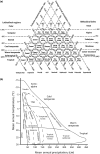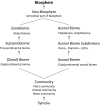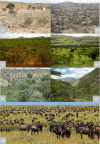Biome: evolution of a crucial ecological and biogeographical concept
- PMID: 30481367
- PMCID: PMC6590505
- DOI: 10.1111/nph.15609
Biome: evolution of a crucial ecological and biogeographical concept
Abstract
A biome is a key community ecological and biogeographical concept and, as such, has profited from the overall progress of community ecology, punctuated by two major innovations: shifting the focus from pure pattern description to understanding functionality, and changing the approach from observational to explanatory and, most importantly, from descriptive to predictive. The functional focus enabled development of mechanistic and function-focused predictive and retrodictive modelling; it also shaped the current understanding of the concept of a biome as a dynamic biological entity having many aspects, with deep roots in the evolutionary past, and which is undergoing change. The evolution of the biome concept was punctuated by three synthetic steps: the first synthesis formulated a solid body of theory explaining the ecological and biogeographical meaning of zonality and collated our knowledge on drivers of vegetation patterns at large spatial scales; the second translated this knowledge into effective mechanistic modelling tools, developing further the link between ecosystem functionality and biogeography; and the third (still in progress) is seeking common ground between large-scale ecological and biogeographic phenomena, using macroecology and macroevolutionary research tools.
Keywords: azonal biomes; biogeography; biome modelling; climate; evolution of biome; genomic tools; plant functional types; vegetation zonality.
© 2018 The Author. New Phytologist © 2018 New Phytologist Trust.
Figures






Comment in
-
Biomes are nobody's kingdom: on environmental and historical plant geography: A comment on Mucina (2019) 'Biome: evolution of a crucial ecological and biogeographical concept'.New Phytol. 2020 Dec;228(5):1460-1462. doi: 10.1111/nph.16300. Epub 2020 Jul 21. New Phytol. 2020. PMID: 32691855 No abstract available.
-
Biomes are everybody's kingdom: a platform where ecology and biogeography meet.New Phytol. 2020 Dec;228(5):1463-1466. doi: 10.1111/nph.16933. Epub 2020 Oct 7. New Phytol. 2020. PMID: 32939763 No abstract available.
Similar articles
-
Biomes are nobody's kingdom: on environmental and historical plant geography: A comment on Mucina (2019) 'Biome: evolution of a crucial ecological and biogeographical concept'.New Phytol. 2020 Dec;228(5):1460-1462. doi: 10.1111/nph.16300. Epub 2020 Jul 21. New Phytol. 2020. PMID: 32691855 No abstract available.
-
Phylogenetic biome conservatism on a global scale.Nature. 2009 Apr 9;458(7239):754-6. doi: 10.1038/nature07764. Epub 2009 Feb 15. Nature. 2009. PMID: 19219025
-
An operational definition of the biome for global change research.New Phytol. 2020 Sep;227(5):1294-1306. doi: 10.1111/nph.16580. Epub 2020 May 12. New Phytol. 2020. PMID: 32255502
-
Biogeography of global drylands.New Phytol. 2021 Jul;231(2):540-558. doi: 10.1111/nph.17395. Epub 2021 May 20. New Phytol. 2021. PMID: 33864276 Review.
-
Disequilibrium vegetation dynamics under future climate change.Am J Bot. 2013 Jul;100(7):1266-86. doi: 10.3732/ajb.1200469. Epub 2013 Jun 10. Am J Bot. 2013. PMID: 23757445 Review.
Cited by
-
Evolutionary Genetics of Cacti: Research Biases, Advances and Prospects.Genes (Basel). 2022 Mar 1;13(3):452. doi: 10.3390/genes13030452. Genes (Basel). 2022. PMID: 35328006 Free PMC article. Review.
-
Forest bathing and hiking benefits for mental health during the COVID-19 pandemic in Mediterranean regions.Eur J For Res. 2023;142(2):415-426. doi: 10.1007/s10342-023-01531-6. Epub 2023 Feb 3. Eur J For Res. 2023. PMID: 36779181 Free PMC article.
-
Macroecology of Abiotic Stress Tolerance in Woody Plants of the Northern Hemisphere: Tolerance Biomes and Polytolerance Hotspots.Ecol Lett. 2024 Nov;27(11):e70016. doi: 10.1111/ele.70016. Ecol Lett. 2024. PMID: 39623739 Free PMC article.
-
Exploring patterns of beta-diversity to test the consistency of biogeographical boundaries: A case study across forest plant communities of Italy.Ecol Evol. 2019 Oct 2;9(20):11716-11723. doi: 10.1002/ece3.5669. eCollection 2019 Oct. Ecol Evol. 2019. PMID: 31695881 Free PMC article.
-
Ecological barriers mediate spatiotemporal shifts of bird communities at a continental scale.Proc Natl Acad Sci U S A. 2023 Jun 6;120(23):e2213330120. doi: 10.1073/pnas.2213330120. Epub 2023 May 30. Proc Natl Acad Sci U S A. 2023. PMID: 37252949 Free PMC article.
References
-
- Ackerly DD. 2003. Community assembly, niche conservatism, and adaptive evolution in changing environments. International Journal of Plant Sciences 164: S165–S184.
-
- Ackerly DD, Cornwell WK. 2007. A trait‐based approach to community assembly: partitioning of species trait values into within‐and among‐community components. Ecology Letters 10: 135–145. - PubMed
-
- Alcaraz‐Segura D, Paruelo JM, Cabello J. 2006. Identification of current distribution of ecosystem functional types in the Iberian Peninsula. Global Ecology and Biogeography 15: 200–210.
-
- Allen TFH, Starr TB. 1982. Hierarchy: perspectives for ecological complexity. Chicago, IL, USA: University of Chicago Press.
MeSH terms
Substances
LinkOut - more resources
Full Text Sources
Miscellaneous

